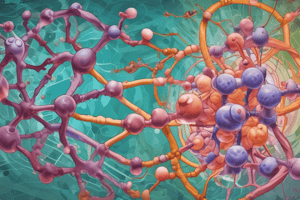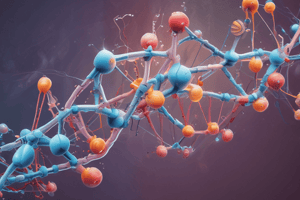Podcast
Questions and Answers
What is the primary mechanism of action of sulfonamides?
What is the primary mechanism of action of sulfonamides?
- Enhance the growth of anaerobic bacteria
- Inhibit DNA replication
- Act as direct antibiotics against Rickettsiae
- Prevent bacterial utilization of PABA for folic acid synthesis (correct)
Which microorganism is known to be resistant to sulfonamides?
Which microorganism is known to be resistant to sulfonamides?
- Pseudomonas aeruginosa (correct)
- Staphylococcus aureus
- Escherichia coli
- Streptococcus pneumoniae
In which scenario should sulfonamides be avoided?
In which scenario should sulfonamides be avoided?
- In patients with viral infections
- In patients with urinary tract infections
- In patients with bacterial infections
- In patients with Rickettsiae infections (correct)
What kind of activity do sulfonamides exhibit against anaerobes?
What kind of activity do sulfonamides exhibit against anaerobes?
What is the absorption characteristic of oral, absorbable sulfonamides?
What is the absorption characteristic of oral, absorbable sulfonamides?
Which of the following is true regarding the distribution of sulfonamides?
Which of the following is true regarding the distribution of sulfonamides?
What role does p-aminobenzoic acid (PABA) serve in bacterial metabolism?
What role does p-aminobenzoic acid (PABA) serve in bacterial metabolism?
Sulfonamides work by having a bacteriostatic effect. What does this mean?
Sulfonamides work by having a bacteriostatic effect. What does this mean?
What is the primary mechanism by which trimethoprim and sulfamethoxazole work together?
What is the primary mechanism by which trimethoprim and sulfamethoxazole work together?
Which condition is considered the drug of choice for trimethoprim-sulfamethoxazole?
Which condition is considered the drug of choice for trimethoprim-sulfamethoxazole?
Which of the following is NOT a potential use of trimethoprim-sulfamethoxazole?
Which of the following is NOT a potential use of trimethoprim-sulfamethoxazole?
What additive effect do trimethoprim and sulfamethoxazole provide?
What additive effect do trimethoprim and sulfamethoxazole provide?
Which drug combination is an example of antifolate drugs?
Which drug combination is an example of antifolate drugs?
Which drug is commonly paired with sulfadiazine in the treatment of certain infections?
Which drug is commonly paired with sulfadiazine in the treatment of certain infections?
What is the primary effect achieved through sequential inhibition of folate synthesis?
What is the primary effect achieved through sequential inhibition of folate synthesis?
Which of the following is primarily responsible for treating urinary tract infections among antifolate drugs?
Which of the following is primarily responsible for treating urinary tract infections among antifolate drugs?
Which of the following infections is NOT typically treated with trimethoprim-sulfamethoxazole?
Which of the following infections is NOT typically treated with trimethoprim-sulfamethoxazole?
What condition does the drug combination of sulfadiazine and pyrimethamine predominantly treat?
What condition does the drug combination of sulfadiazine and pyrimethamine predominantly treat?
What are common gastrointestinal adverse reactions associated with fluoroquinolones?
What are common gastrointestinal adverse reactions associated with fluoroquinolones?
Which generation of fluoroquinolones are characterized by excellent activity against Gram-negative bacteria?
Which generation of fluoroquinolones are characterized by excellent activity against Gram-negative bacteria?
What is a significant adverse reaction associated with fluoroquinolone use in elderly patients?
What is a significant adverse reaction associated with fluoroquinolone use in elderly patients?
Which of the following adverse effects is NOT typically associated with fluoroquinolone usage?
Which of the following adverse effects is NOT typically associated with fluoroquinolone usage?
What is a common suffix used for Fluoroquinolones?
What is a common suffix used for Fluoroquinolones?
Which bacterial infections can Fluoroquinolones help treat?
Which bacterial infections can Fluoroquinolones help treat?
What change in a microorganism can lead to decreased accumulation of Fluoroquinolones?
What change in a microorganism can lead to decreased accumulation of Fluoroquinolones?
Which of the following Fluoroquinolones is NOT mentioned in the content?
Which of the following Fluoroquinolones is NOT mentioned in the content?
What is the mechanism of action of Fluoroquinolones?
What is the mechanism of action of Fluoroquinolones?
What type of mutations can confer resistance to DNA gyrase inhibitors?
What type of mutations can confer resistance to DNA gyrase inhibitors?
What is one of the major clinical uses of Fluoroquinolones?
What is one of the major clinical uses of Fluoroquinolones?
What effect does altering the target enzyme have on the effectiveness of Fluoroquinolones?
What effect does altering the target enzyme have on the effectiveness of Fluoroquinolones?
Which of these is a mechanism of resistance associated with DNA gyrase inhibitors?
Which of these is a mechanism of resistance associated with DNA gyrase inhibitors?
What is the primary action of DNA gyrase inhibitors?
What is the primary action of DNA gyrase inhibitors?
Which of the following antibiotics is considered the first-line treatment for prostatitis?
Which of the following antibiotics is considered the first-line treatment for prostatitis?
Which infection is treated with Levofloxacin among the following options?
Which infection is treated with Levofloxacin among the following options?
What does the inhibition of topoisomerase IV affect in bacterial cells?
What does the inhibition of topoisomerase IV affect in bacterial cells?
In terms of spectrum of activity, what is the primary benefit of lower generation DNA gyrase inhibitors?
In terms of spectrum of activity, what is the primary benefit of lower generation DNA gyrase inhibitors?
Which of the following conditions is not typically treated with DNA gyrase inhibitors?
Which of the following conditions is not typically treated with DNA gyrase inhibitors?
Ciprofloxacin is primarily indicated for which type of infection?
Ciprofloxacin is primarily indicated for which type of infection?
The mechanism of action for the antibiotic class that includes Levofloxacin primarily involves which of the following?
The mechanism of action for the antibiotic class that includes Levofloxacin primarily involves which of the following?
Which fluoroquinolone antibiotic is specifically mentioned for treating respiratory tract infections?
Which fluoroquinolone antibiotic is specifically mentioned for treating respiratory tract infections?
What is a significant consequence of the bacteriostatic effect of sulfonamides?
What is a significant consequence of the bacteriostatic effect of sulfonamides?
Why should sulfonamides be avoided in patients with Rickettsiae infections?
Why should sulfonamides be avoided in patients with Rickettsiae infections?
What is the absorption characteristic of non-absorbable oral sulfonamides?
What is the absorption characteristic of non-absorbable oral sulfonamides?
How do DNA gyrase inhibitors affect bacterial cells?
How do DNA gyrase inhibitors affect bacterial cells?
In terms of bacterial resistance, what effect does altering the target enzyme for DNA gyrase inhibitors have?
In terms of bacterial resistance, what effect does altering the target enzyme for DNA gyrase inhibitors have?
Which characteristic of pseudomonas aeruginosa is relevant to sulfonamide treatment?
Which characteristic of pseudomonas aeruginosa is relevant to sulfonamide treatment?
What type of microorganisms are sulfonamides specifically designed to target?
What type of microorganisms are sulfonamides specifically designed to target?
What is a common result of increasing generations of DNA gyrase inhibitors?
What is a common result of increasing generations of DNA gyrase inhibitors?
What is the primary reason for combining trimethoprim with sulfamethoxazole?
What is the primary reason for combining trimethoprim with sulfamethoxazole?
Which of the following infections is considered a primary use case for trimethoprim-sulfamethoxazole?
Which of the following infections is considered a primary use case for trimethoprim-sulfamethoxazole?
Which of the following agents is commonly used in combination therapy with antifolate drugs?
Which of the following agents is commonly used in combination therapy with antifolate drugs?
Which of the following statements about oral absorbable agents is true?
Which of the following statements about oral absorbable agents is true?
What mechanism do antifolate drugs utilize to achieve their bactericidal effect?
What mechanism do antifolate drugs utilize to achieve their bactericidal effect?
What is one of the consequences of sequential inhibition of folate synthesis by antifolate drugs?
What is one of the consequences of sequential inhibition of folate synthesis by antifolate drugs?
Which drug is often considered first-line therapy for urinary tract infections among antifolate agents?
Which drug is often considered first-line therapy for urinary tract infections among antifolate agents?
Which combination is used for treating toxoplasmosis?
Which combination is used for treating toxoplasmosis?
Trimethoprim-sulfamethoxazole is often indicated for which of the following infections?
Trimethoprim-sulfamethoxazole is often indicated for which of the following infections?
What is a notable adverse effect associated with fluoroquinolone use in elderly patients?
What is a notable adverse effect associated with fluoroquinolone use in elderly patients?
What effect does tendonitis associated with fluoroquinolone use have on patients?
What effect does tendonitis associated with fluoroquinolone use have on patients?
What suffix is commonly associated with Fluoroquinolones?
What suffix is commonly associated with Fluoroquinolones?
Which generation of fluoroquinolones offers improved activity against Gram-positive bacteria?
Which generation of fluoroquinolones offers improved activity against Gram-positive bacteria?
What is a common gastrointestinal adverse reaction associated with fluoroquinolones?
What is a common gastrointestinal adverse reaction associated with fluoroquinolones?
Which Fluoroquinolone is indicated for treating bacterial diarrhea caused by both Shigella and Salmonella?
Which Fluoroquinolone is indicated for treating bacterial diarrhea caused by both Shigella and Salmonella?
What change in a microorganism can lead to decreased accumulation of Fluoroquinolones?
What change in a microorganism can lead to decreased accumulation of Fluoroquinolones?
What is one of the mechanical actions of Fluoroquinolones?
What is one of the mechanical actions of Fluoroquinolones?
Which of the following describes a target alteration that can cause Fluoroquinolone resistance?
Which of the following describes a target alteration that can cause Fluoroquinolone resistance?
What is a major clinical use of Fluoroquinolones?
What is a major clinical use of Fluoroquinolones?
What effect does a change in the target enzyme have on the effectiveness of Fluoroquinolones?
What effect does a change in the target enzyme have on the effectiveness of Fluoroquinolones?
What role does topoisomerase IV play in bacterial DNA replication?
What role does topoisomerase IV play in bacterial DNA replication?
Which fluoroquinolone is considered the first-line drug for treating prostatitis?
Which fluoroquinolone is considered the first-line drug for treating prostatitis?
Which generation of fluoroquinolones is known to have more effects on gram-positive bacteria?
Which generation of fluoroquinolones is known to have more effects on gram-positive bacteria?
In terms of spectrum of activity, what primary effect is observed with lower generation DNA gyrase inhibitors?
In terms of spectrum of activity, what primary effect is observed with lower generation DNA gyrase inhibitors?
Which fluoroquinolone is indicated for treating gastrointestinal infections?
Which fluoroquinolone is indicated for treating gastrointestinal infections?
What is a significant consequence of inhibiting topoisomerase II in bacteria?
What is a significant consequence of inhibiting topoisomerase II in bacteria?
Which condition is NOT typically treated with fluoroquinolones?
Which condition is NOT typically treated with fluoroquinolones?
What is the primary clinical use of Levofloxacin?
What is the primary clinical use of Levofloxacin?
What effect does DNA gyrase inhibition have on positively supercoiled DNA?
What effect does DNA gyrase inhibition have on positively supercoiled DNA?
Flashcards are hidden until you start studying
Study Notes
Antifolate Drugs
- Structurally resemble p-aminobenzoic acid (PABA); important for folate synthesis.
- Bacteriostatic action, inhibiting bacterial utilization of PABA to synthesize folic acid, halting nucleic acid synthesis.
- Poor efficacy against anaerobes and certain resistant bacteria, notably Pseudomonas aeruginosa.
- Pharmacokinetics:
- Oral, absorbable forms are widely distributed in tissues and body fluids, including the central nervous system.
- Non-absorbable oral formulations are used topically.
- Clinical uses include combination therapy with dihydrofolate reductase inhibitors (e.g., trimethoprim) for enhanced bactericidal effects.
- Trimethoprim-Sulfamethoxazole (co-trimoxazole) is used as the first-line treatment for:
- Pneumocystis jirovecii pneumonia
- Toxoplasmosis
- Nocardiosis
- Urinary tract infections, Listeriosis, Shigellosis.
- Common oral absorbable agents include Sulfisoxazole and Sulfamethoxazole.
DNA Gyrase Inhibitors
- Fluroquinolones, characterized by the suffix “-floxacin”, include Ciprofloxacin, Norfloxacin, Levofloxacin, Moxifloxacin, and Enoxacin.
- Mechanism of action:
- Inhibit bacterial topoisomerases II (DNA gyrase) and IV, impairing DNA replication.
- Spectrum of activity:
- Higher generation fluoroquinolones demonstrate more effectiveness against gram-positive bacteria.
- Lower generations are stronger against gram-negative bacteria.
- Clinical applications:
- Urinary tract infections, including those caused by Pseudomonas aeruginosa.
- Bacterial diarrhea from Shigella, Salmonella, Toxigenic E. coli, and Campylobacter.
- Respiratory tract infections, with specific drugs like Levofloxacin used for acute bacterial bronchitis and community-acquired pneumonia.
- Levofloxacin is the recommended first-line agent for treating prostatitis.
- Adverse reactions may include:
- Gastrointestinal upset: nausea, vomiting, diarrhea.
- Central nervous system effects: headache, dizziness, confusion, potentially seizures.
- Photosensitivity, skin reactions (rashes, pruritus).
- Connective tissue effects, such as cartilage erosion and teratogenicity, especially concerning in pregnant or breastfeeding patients.
- Other risks include QT prolongation, tendonitis, and increased risk of tendon rupture, particularly in the elderly.
Antifolate Drugs
- Structurally resemble p-aminobenzoic acid (PABA); important for folate synthesis.
- Bacteriostatic action, inhibiting bacterial utilization of PABA to synthesize folic acid, halting nucleic acid synthesis.
- Poor efficacy against anaerobes and certain resistant bacteria, notably Pseudomonas aeruginosa.
- Pharmacokinetics:
- Oral, absorbable forms are widely distributed in tissues and body fluids, including the central nervous system.
- Non-absorbable oral formulations are used topically.
- Clinical uses include combination therapy with dihydrofolate reductase inhibitors (e.g., trimethoprim) for enhanced bactericidal effects.
- Trimethoprim-Sulfamethoxazole (co-trimoxazole) is used as the first-line treatment for:
- Pneumocystis jirovecii pneumonia
- Toxoplasmosis
- Nocardiosis
- Urinary tract infections, Listeriosis, Shigellosis.
- Common oral absorbable agents include Sulfisoxazole and Sulfamethoxazole.
DNA Gyrase Inhibitors
- Fluroquinolones, characterized by the suffix “-floxacin”, include Ciprofloxacin, Norfloxacin, Levofloxacin, Moxifloxacin, and Enoxacin.
- Mechanism of action:
- Inhibit bacterial topoisomerases II (DNA gyrase) and IV, impairing DNA replication.
- Spectrum of activity:
- Higher generation fluoroquinolones demonstrate more effectiveness against gram-positive bacteria.
- Lower generations are stronger against gram-negative bacteria.
- Clinical applications:
- Urinary tract infections, including those caused by Pseudomonas aeruginosa.
- Bacterial diarrhea from Shigella, Salmonella, Toxigenic E. coli, and Campylobacter.
- Respiratory tract infections, with specific drugs like Levofloxacin used for acute bacterial bronchitis and community-acquired pneumonia.
- Levofloxacin is the recommended first-line agent for treating prostatitis.
- Adverse reactions may include:
- Gastrointestinal upset: nausea, vomiting, diarrhea.
- Central nervous system effects: headache, dizziness, confusion, potentially seizures.
- Photosensitivity, skin reactions (rashes, pruritus).
- Connective tissue effects, such as cartilage erosion and teratogenicity, especially concerning in pregnant or breastfeeding patients.
- Other risks include QT prolongation, tendonitis, and increased risk of tendon rupture, particularly in the elderly.
Studying That Suits You
Use AI to generate personalized quizzes and flashcards to suit your learning preferences.





